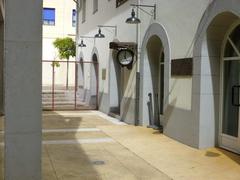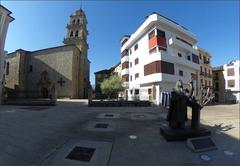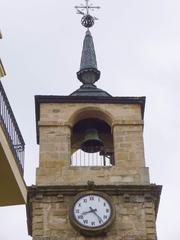Visiting Columbrianos in Ponferrada, Spain: Guide, Tickets, Hours, and Tips
Date: 15/06/2025
Introduction: Discover Columbrianos and Its Historical Significance
Columbrianos, nestled in the picturesque Bierzo region of León, Spain, is a captivating hamlet just over 2 kilometers from Ponferrada. Steeped in ancient history and rich cultural traditions, Columbrianos stands as a vital waypoint on the Camino de Santiago pilgrimage route. Its roots reach back to pre-Roman times, with archaeological sites like the Castro de Columbrianos highlighting its significance as one of El Bierzo’s oldest continuously inhabited areas (La Nueva Crónica, Senditur).
The hamlet flourished during Roman times, benefitting from its proximity to the Las Médulas gold mines and the fertile Sil River plains. As the Camino Francés gained prominence in the Middle Ages, Columbrianos became a refuge for pilgrims, marked by religious landmarks like the Romanesque Parish Church of San Esteban and the hermitages of San Blas and San Juan (Spain.info, CaminoApp).
Modern Columbrianos retains its vibrant identity, offering visitors a blend of medieval architecture, archaeological remains, and lively festivals. Its close integration with Ponferrada connects travelers to iconic sites such as the Templar Castle and the Basilica de la Encina (Turismo Castilla y León). This guide provides essential visitor information, including opening hours, ticket details, accessibility, travel tips, and nearby attractions.
Table of Contents
- Early Origins and Pre-Roman Heritage
- Roman and Medieval Development
- Religious and Architectural Heritage
- The Camino de Santiago and Pilgrimage Culture
- Integration with Ponferrada
- Notable Features and Events
- Visitor Information (Hours, Tickets, Accessibility, Tips)
- Nearby Attractions
- Visuals and Interactive Resources
- Frequently Asked Questions (FAQ)
- Conclusion
Early Origins and Pre-Roman Heritage
Archaeological records confirm human settlement in Columbrianos dating back to at least 700 BCE. The Castro de Columbrianos, an oval-shaped hillfort with robust stone walls, underscores the area’s strategic importance in the Bierzo valley (La Nueva Crónica). Its location provided defense and oversight of fertile land near the Sil River, making it attractive for ancient agricultural communities (Turismo Castilla y León).
Roman and Medieval Development
The Roman era saw Columbrianos benefit from its proximity to the Las Médulas gold mines and the expansion of Roman infrastructure. The village’s name may derive from the Latin “Columbarium,” a nod to historic dovecotes or pigeon-rearing, which became prominent in later centuries (CaminoApp). In the Middle Ages, Columbrianos rose in importance as part of the Camino Francés, linking it to the broader economic and cultural networks of the pilgrimage route.
Religious and Architectural Heritage
Central to Columbrianos’ charm is the Parish Church of San Esteban—a 12th-century Romanesque church featuring a richly decorated apse with corbels and a distinctive frieze. The church is open daily from 9:00 AM to 6:00 PM, with free admission (Spain.info). The hermitages of San Blas and San Juan, adorned with unique elm-wood carvings, further enrich the religious landscape.
The Camino de Santiago and Pilgrimage Culture
Columbrianos has long welcomed pilgrims traversing the Camino Francés. Its albergues and inns offer amenities tailored to pilgrims’ needs, especially during the peak season from April to October (CaminoApp). Annual festivals, including those for San Esteban and San Blas, immerse visitors in vibrant local traditions.
Integration with Ponferrada
As a neighborhood of Ponferrada, Columbrianos enjoys easy access to the city’s historical gems, such as the 12th-century Templar Castle (open daily 10:00 AM–8:00 PM, ~€6 entry) and the Basilica de la Encina. The region’s unique microclimate supports vineyards and orchards, shaping the area’s celebrated gastronomy (Turismo Castilla y León).
Notable Features and Events
Manor houses and estates, such as Regalao and Tormaleo, reflect Columbrianos’ agricultural heritage. Annual festivals honoring San Esteban (December 26) and San Blas (February 3) feature processions, music, and traditional foods, providing an authentic glimpse into village life.
Visitor Information
Visiting Hours
- Parish Church of San Esteban: 9:00 AM–6:00 PM daily
- Hermitages: Accessible year-round
Tickets
- Most sites in Columbrianos are free to enter
- Templar Castle in Ponferrada: ~€6 entry fee
Accessibility
- Paths are pedestrian-friendly, though some may have uneven surfaces
- Limited wheelchair access in some historic sites
Special Events
- Festivals: San Esteban (Dec 26), San Blas (Feb 3) — free public participation
Travel Tips
- Best season: Spring to early autumn, for mild weather and active pilgrim flows
- Public transport: Local buses and taxis connect Ponferrada and Columbrianos
Nearby Attractions
- Templar Castle (Castillo de los Templarios): 12th-century fortress with panoramic city views
- Basilica de la Encina: Noted for Renaissance architecture
- El Bierzo Museum: Archaeology and ethnography of the region
- Las Médulas: UNESCO World Heritage Roman mining landscape
Visuals and Interactive Resources
- Images: Parish Church of San Esteban, hermitages, Bierzo valley (with alt text: e.g., “Romanesque Parish Church of San Esteban in Columbrianos”)
- Interactive map: Camino de Santiago route through Columbrianos and key local landmarks
Frequently Asked Questions (FAQ)
Q: What are the main visiting hours for Columbrianos’ sites?
A: The Parish Church of San Esteban is open daily 9:00 AM–6:00 PM; hermitages are accessible year-round.
Q: Are entrance fees required?
A: Entry to most sites in Columbrianos is free; Ponferrada’s Templar Castle requires a ticket.
Q: How can I reach Columbrianos from Ponferrada?
A: By local bus or taxi; the hamlet is just over 2 km from Ponferrada’s center.
Q: When is the best time to visit?
A: From spring through early autumn, especially during local festivals.
Q: Are there accommodations for pilgrims?
A: Yes, Columbrianos offers several inns and albergues for Camino pilgrims.
Conclusion and Call to Action
Columbrianos is more than a scenic stop on the Camino de Santiago; it’s a living testament to centuries of settlement, spiritual devotion, and vibrant tradition. Its pre-Roman castros, Romanesque architecture, and festive local culture invite every visitor to step into history. With proximity to Ponferrada’s treasures and El Bierzo’s culinary delights, Columbrianos is an ideal base for exploring northwestern Spain.
Plan your visit today: Download the Audiala app for interactive maps, up-to-date event schedules, and guided tours. Follow us on social media for the latest travel tips and regional highlights. Experience the harmony of history, hospitality, and natural beauty in Columbrianos and Ponferrada!
Sources
- La Nueva Crónica
- Senditur
- Spain.info
- CaminoApp
- Turismo Castilla y León
- Turismo Castilla y León - Ponferrada
- Ponferrada Official Tourism Website
- Camino de Santiago Official Site
- Barceló Experiences
- Ayuntamiento de Ponferrada



